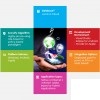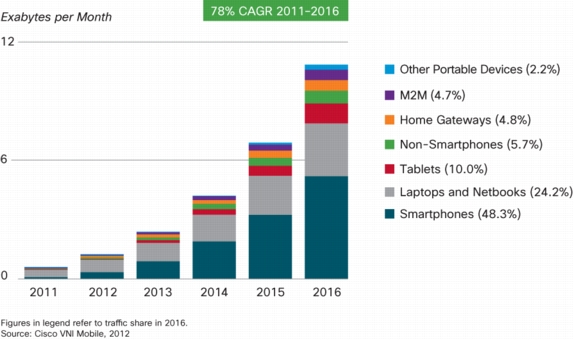Teaming Up with the Right Partner for Enabling Next-gen Enterprise Mobility

As a CIO, all these years you have been managing a huge onus of myriad of IT goals and challenges. You have been instrumental in a slew of tactical and operational responsibilities that include developing an IT policy, administration of IT platforms, supervising technical infrastructure, managing business delivery solutions and mentoring other critical activities such as maintaining web systems, customer management platforms, workflow applications and the like. Also you have been expected to ensure adequate management of IT services, safeguard system health and smooth execution of projects. Phew! Seems you have been spreading yourself too thin. But is it over? Not really. With smartphone saga ushering in an avalanche of new devices and mobility patterns, CIOs the world over are coping with a plethora of unprecedented challenges in enterprise mobility.
Teaming Up with the Right Partner
True enterprise mobility, as it seems today is all about what mobile workforce expect as consumers and what CIOs and IT managers want for productivity, visibility, collaboration, cost savings and better customer and workforce engagement. However, it is only a simple statement and it’s easier said than done.
For CIOs, designing comprehensive yet sustainable enterprise mobility plan involves certain key technology decisions that involve choice of devices, choosing the right network operator and ISP and host of other enterprise IT aspects such as middleware platform, development environment & suitable tools, application types and integration methodology. Doing this requires partnering with a turn-key solution provider that brings comprehensive expertise into these areas.
We at Ascenten with our in-depth awareness of these domains and in-house team of embedded software and hardware engineers, programmers and network professionals can help you fathom these difficult aspects and serve you with one-stop-shop convenience in implementing a fitting enterprise mobility strategy.
What Can Ascenten Offer:
Widespread adoption of smartphones, tablets, and other smart devices enabled by next-generation high-speed networks such as 3G and 4G has given rise to a whole new world of mobile-social work and life culture. These devices and technologies have become entrenched with our routine. Today’s mobile workforce inevitably depends on them to plan and manage their day, work and life. Emergence of new mobile ecosystems and explosion of innovative applications are adding extra influence on this scenario.
Key Insights:
- As per one study by International Data Corp. (IDC), by 2015 the world’s mobile worker population will exceed 1.3 billion, more than 37 % of the total workforce. The Asia/Pacific region shall witness the largest increase, rising from 601.7 million in 2010 to 838.7 million in 2015
- Mobile social media is affecting the way employees manage not only their personal lives but also their professional work. Taking instant access to the next level, smart devices are making it easier than ever to handle most professional tasks such as managing emails to hosting a conference call to collaborating on documents, all on the go
- By the end of 2012, the number of mobile-connected devices will exceed the number of people on earth, and by 2016 there will be 1.4 mobile devices per capita. There will be over 10 billion mobile-connected devices in 2016, including machine-to-machine (M2M) modules-exceeding the world’s population at that time (7.3 billion)
- Mobile-connected tablets will generate almost as much traffic in 2016 as the entire global mobile network in 2012. The amount of mobile data traffic generated by tablets in 2016 (1.1 exabytes per month) will be approximately equal to the total amount of global mobile data traffic in 2012 (1.3 exabytes per month)
Devices Responsible for Mobile Data Traffic Growth

Key Considerations in Enabling Next-Generation Enterprise Mobility
As one industry luminary rightly points out, today’s workforce is increasingly independent and mobile, forcing businesses to pursue cost-containing yet innovative enterprise mobility arrangements that improve their bottom line while enabling improved communication and reach for employees. Therefore in this new era, convenience and savings are no longer conflicting forces. Enterprise mobility is on the verge of a paradigm shift that shall boost productivity by unleashing business office functionality beyond the brick-and-mortar setting. Anytime, anywhere and on any device access to a virtual office comprising an assistant, meeting-room convenience and other communication features is merely a few clicks away. Indeed, there are prospects galore; however, CIOs need to take into account implied cost, governance and security challenges too. Never before in history of enterprise IT management have CIOs found observations such as the following more compelling.
- Absence of approvers amounting to substantial loss of time
- Amount of revenue loss / lost opportunities due to lack of timely access to the right data
- Knowing if company’s own mobile workforce is making the environment vulnerable to security concerns and knowing if productive time is being lost in non-productive work (e.g. prolonged submissions or approvals) which could have been completed while on the move
- Can undesired customer visits be avoided by making available desired information more quickly?
- Determining optimal waiting time for customers trying to connect
- Better operational efficiency and visibility into inventory and other assets to enable informed decisions
Notable Developments and Emerging Trends in Mobile Ecosystem
With changing dynamics in mobile technology and rapid strides being made through emerging mobile ecosystem, computing needs are moving more to the mobile side. Business enterprises and workforce therefore find it indispensable to have their data and emails along with the computing power so that they can do more things quickly, no matter where they are. As a result, they are developing a preference for a device that can let them manage different communications and provide them with task synchronization for their routine professional and personal needs without having to go through hurdles of size, wires and location. Indeed, smartphones have been able to fulfill these needs to a reasonable extent. However, now is the time to seek little extra power, comfort and choice of screen real estate for a device that offers seamless synchronization with your PC and other handheld devices, thereby letting you to continue from the same point where you left off.
Last few weeks have witnessed mobile tech industry’s leading players unveiling a range of innovative software and hardware platforms, all set to influence radical impact and series of roll-outs before the end of the year. Apple for example has launched iOS 6 and the new MacBook Pros, Microsoft on the other hand unveiled the new Surface and is preparing Windows 8 for launch and Google has uncovered the new version of Android based Nexus. All these together shall stir up the mobile technology product market.
What’s in Store for Mobile Workforce?
These new devices will draw immense attention from enterprise IT decision makers and mobile taskforce alike. Armed with cutting-edge communication and task organization capabilities offered by these devices, users will experience evident improvement in productivity. Business enterprises too will benefit from the same since their employees would now have access to tools that will ensure efficient accomplishment of work.
Apple
The company launched new iPhone and iOS 6 this September. In recent years, Apple has succeeded in shifting its brand positioning from luxury to the mainstream. With this it is gaining higher acceptance among business users and mobile workforce too. The company, with a view to sustaining its success is also reducing prices for products such as MacBook Air.
The search engine giant unveiled Google Play and Jelly Bean (Android 4.1) in July this year. With this Google made an unprecedented move to unify its offerings. Unlike earlier versions of Android, where different device makers are offering different flavors of the platform, while some having to depend on their tie-up with network operators for firmware upgrade, Android 4.1 changes it all by unifying everything together.
Microsoft
Microsoft shall steal industry spotlight on October 26, 2012 by launching an array of next-generation software and mobility capabilities including Windows 8, Windows RT and its much awaited tablet ‘Microsoft Surface ’. With Windows 8, Microsoft is all set to unveil a host of revolutionary features that are in sync with enterprise mobility evolution and shall serve remote workers and mobile employees with desired level of mobile productivity, security, manageability and virtualization needs. Besides, the company will also give rise to a phenomenon whereby users are able to bring their work, life, friends and family into one single ecosystem, enabled by a seamlessly collaborative platform.
Windows RT (runtime) is an OEM only edition and will not be offered for retail purchase in stores. Focused on tablet devices and designed to run on smart devices powered by ARM based chips, Windows RT is one of the three editions of forthcoming Windows 8. It will power ARM based tablets, low-cost notebooks and other mobile devices from a variety of OEMs and also Microsoft’s own tablet device, the Microsoft Surface Tablet.
Leading chip maker Intel together with its partners (OEM partners and device makers including Acer, ASUS, Dell, Fujitsu, HP, Lenovo, LG Electronics, Samsung and ZTE) too has announced to unveil a range of tablet designs and experiences running Windows 8.
Heralding a New Era in Enterprise Mobility – Windows 8
IT service / solution providers may prefer Windows 8 based tablets over iPads since they will find these devices simpler and familiar to manage, just like their routine IT infrastructure. Moreover, with Microsoft having made an announcement to release Windows Intune and System Center 2012 Configuration Manager (to manage Windows RT and Windows Phone 8 mobile devices), system admins will have access to a console to set mobile security policies, distribute mobile apps and view reports. End users on the other hand too will like new windows tablets due to the UI transformation and legacy windows support.
IT decision makers can also consider encouraging their employees to buy such devices by adopting a rapidly emerging trend called ‘BYOD’, which stands for ‘bring your own device’. This certainly seems rewarding for enterprise mobility whereby businesses are able to grant privileged access to company’s information resources while saving substantial investment in buying new devices.





No Comments